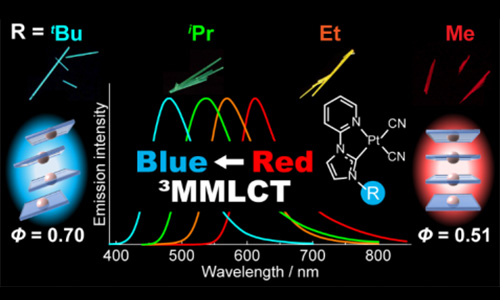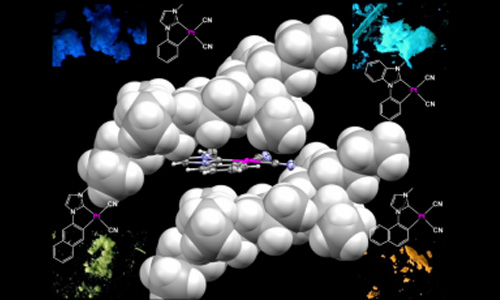We have been developing chromic metal complexes that exhibit color and luminescence changes in response to environmental change or various stimuli. In particular, we focus on “soft crystals”, which respond to gentle stimuli such as vapor exposure and rubbing but maintain their structural order, and exhibit remarkable visual changes in their shape, color, and luminescence.
Approach
Approach 1. Design & Synthesis
Create photofunctional metal complexes (Design & Synthesis)
Approach 2. Luminescence & Chromism
Investigate luminescence properties and stimuli-responsive color changes (chromism)
Approach 3. Structure & Photofunction
Explore functions based on the molecular and crystal structure analyses
Theme 1
Control of stimulus response and functionalization of smart soft crystals using luminescent metal complexes
 You may imagine crystals are hard and stable materials like diamond and quartz that are distinct from liquids and polymers. However, “soft crystals” respond to gentle stimuli such as vapor exposure and rubbing but maintain their structural order and exhibit remarkable visual changes in their shape, color, and luminescence. In my laboratory, we have been developing such soft crystals based on the metal-metal interactions, π/π interactions, and hydrogen bonds using luminescent Pt(II) complexes.
You may imagine crystals are hard and stable materials like diamond and quartz that are distinct from liquids and polymers. However, “soft crystals” respond to gentle stimuli such as vapor exposure and rubbing but maintain their structural order and exhibit remarkable visual changes in their shape, color, and luminescence. In my laboratory, we have been developing such soft crystals based on the metal-metal interactions, π/π interactions, and hydrogen bonds using luminescent Pt(II) complexes.
Theme 2
Creation and elucidation of metal complexes that exhibit characteristic luminescence
We develop novel metal complexes by drawing out new properties of metal complexes such as triboluminescence and luminescence in liquid state, and elucidate the mechanism and principle. In addition, from the viewpoint of effective utilization of elements, our laboratory also focuses on the fabrication of luminescent Cu(I) and other 3d metal complexes as the next-generation emissive materials that replace expensive noble metal complexes.




